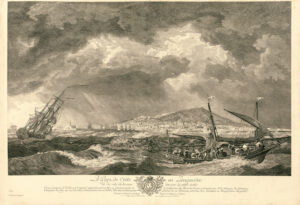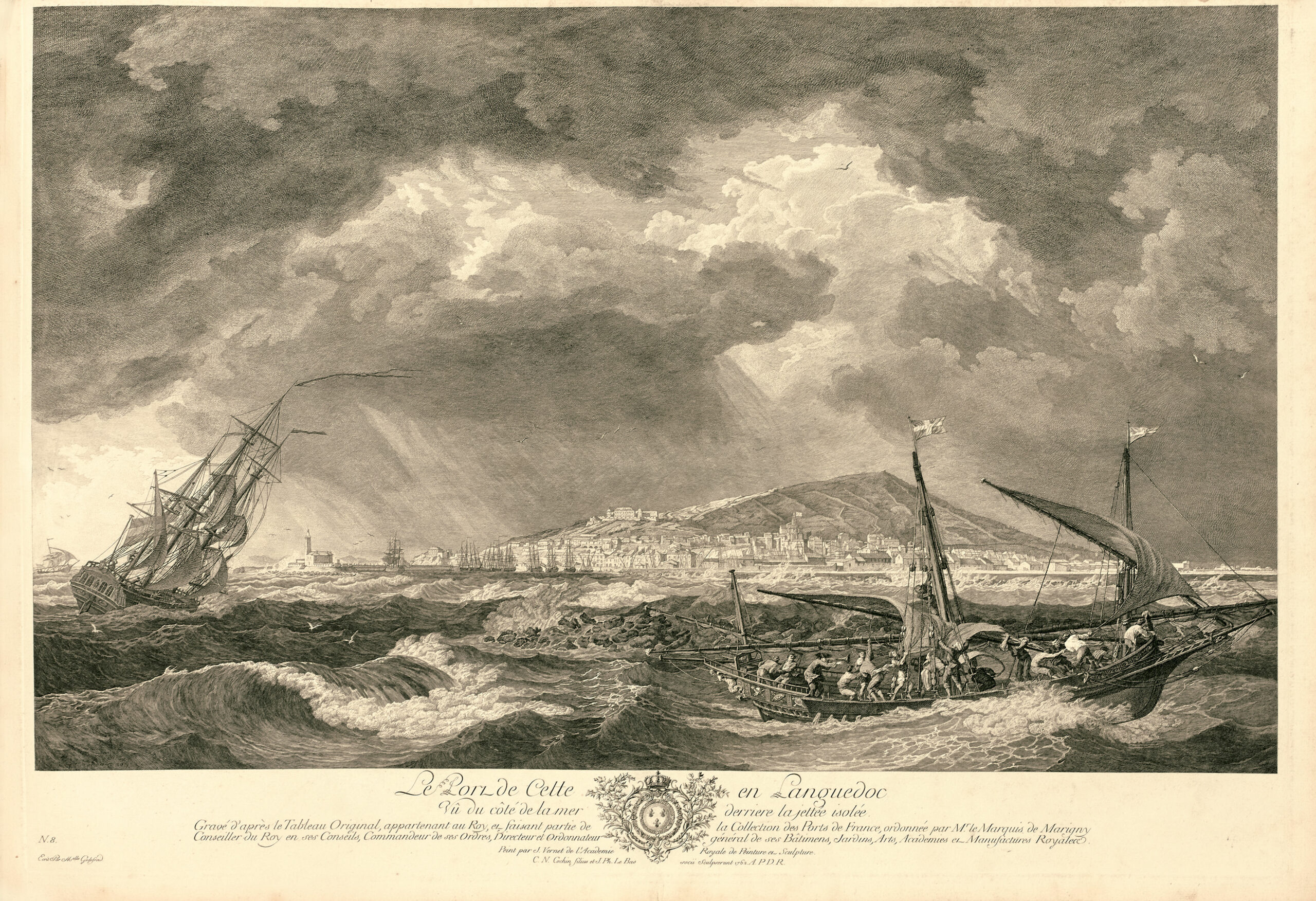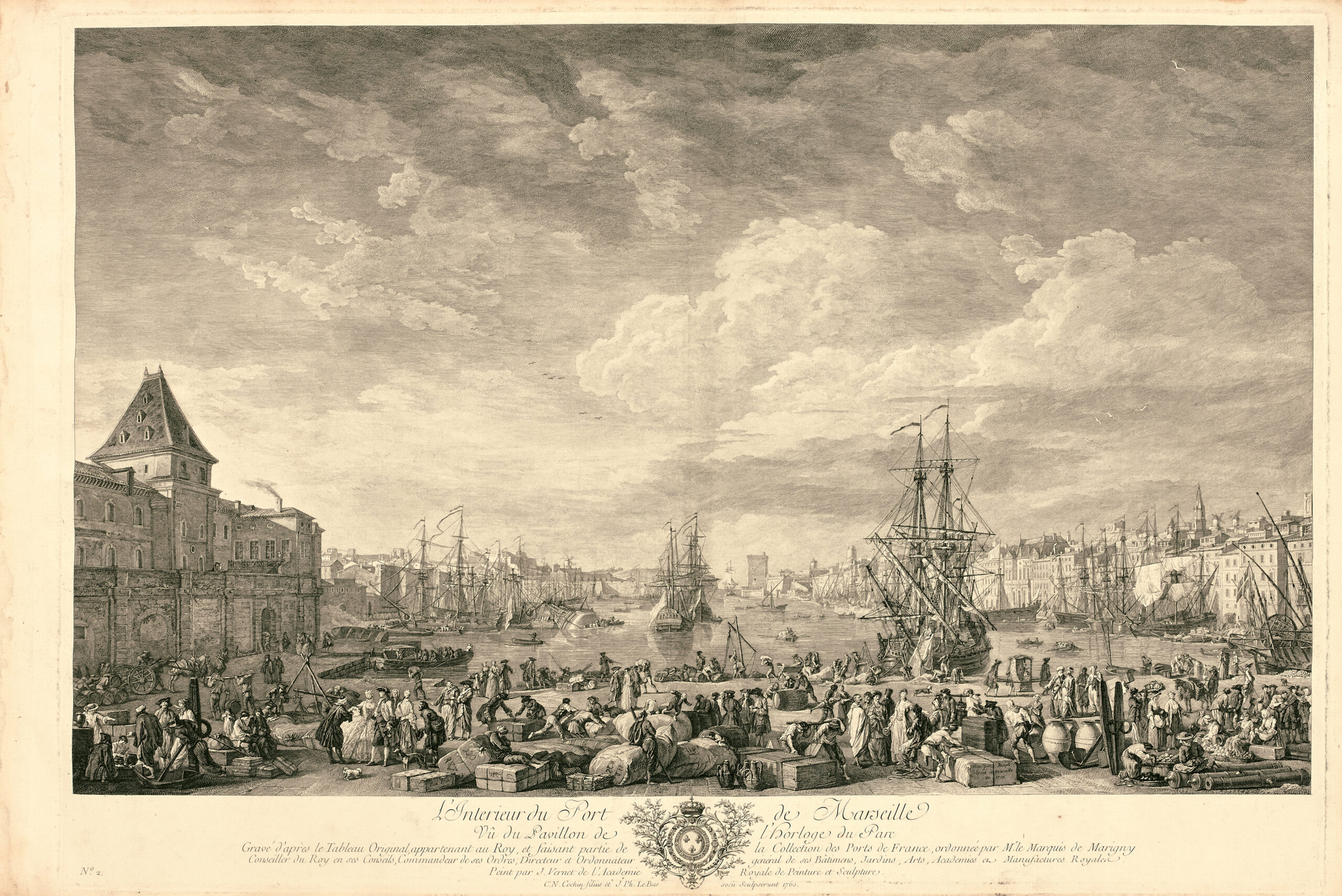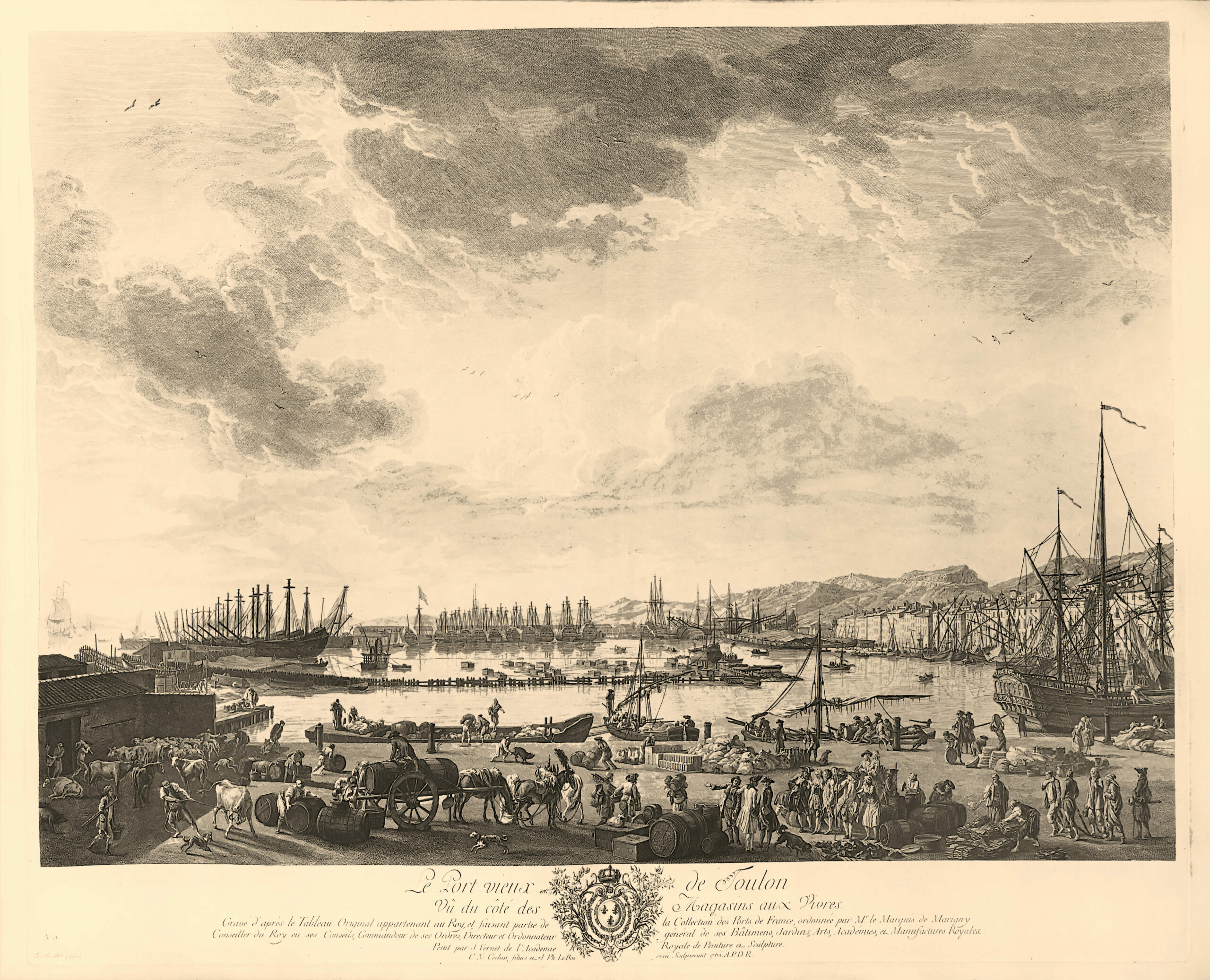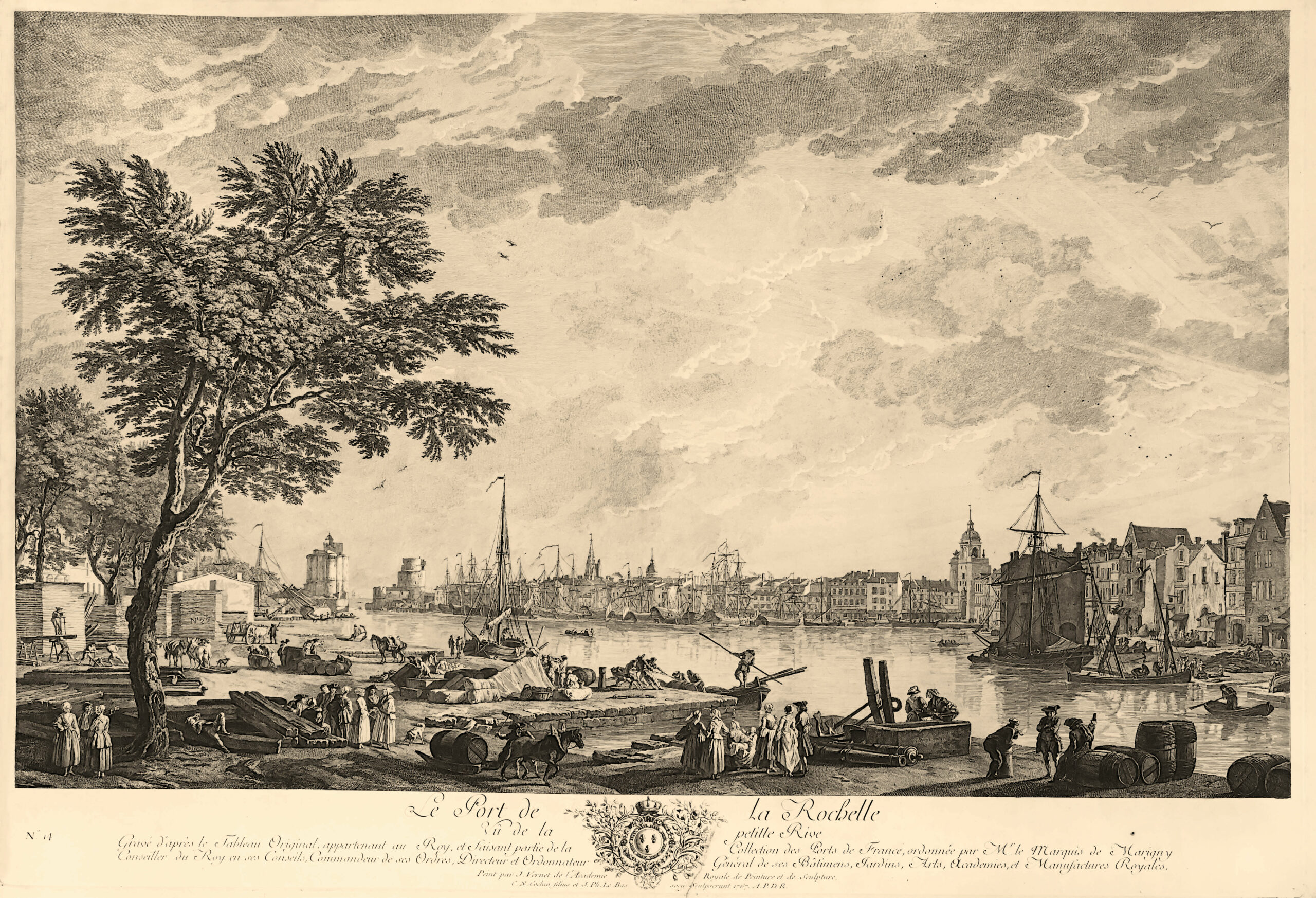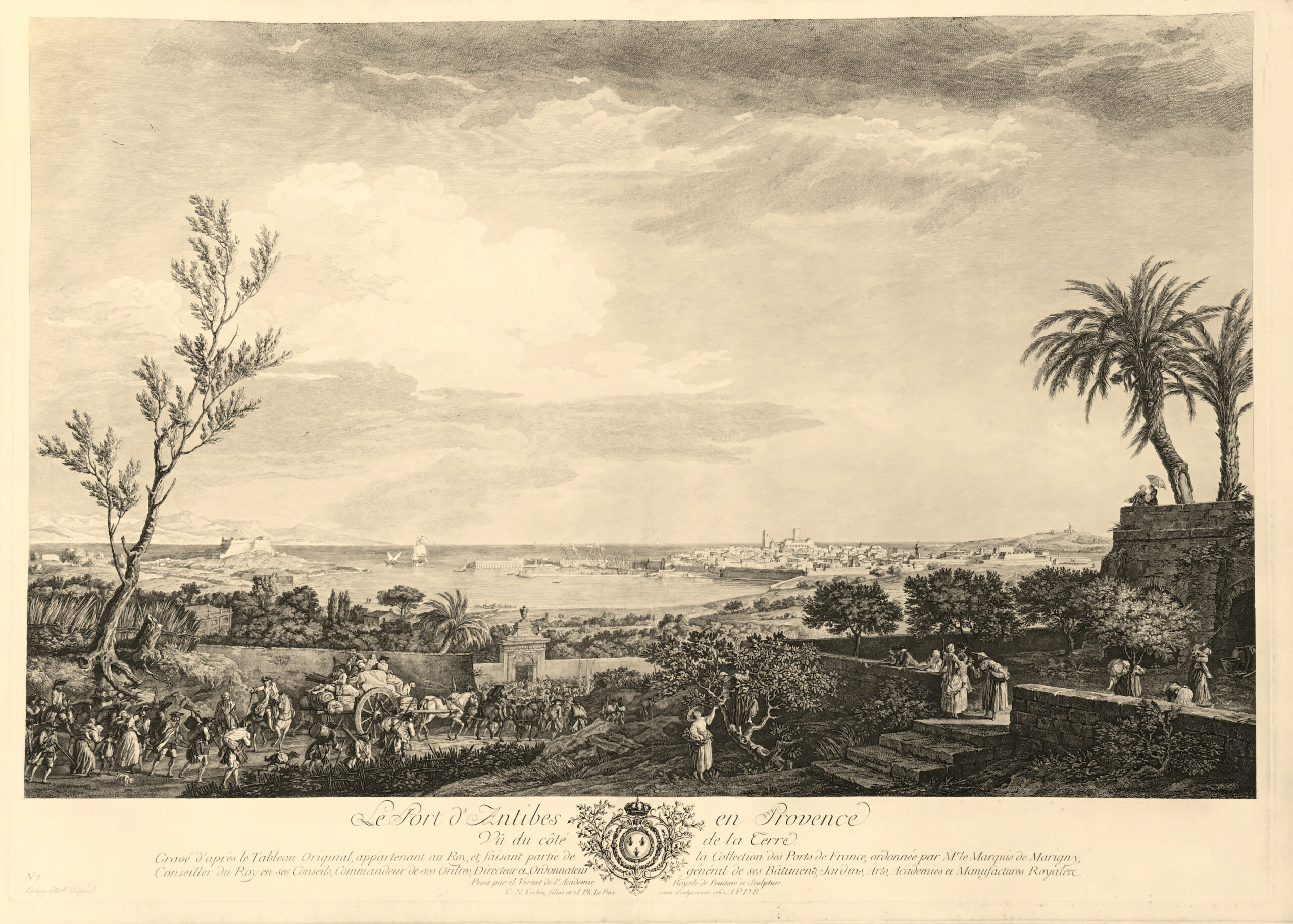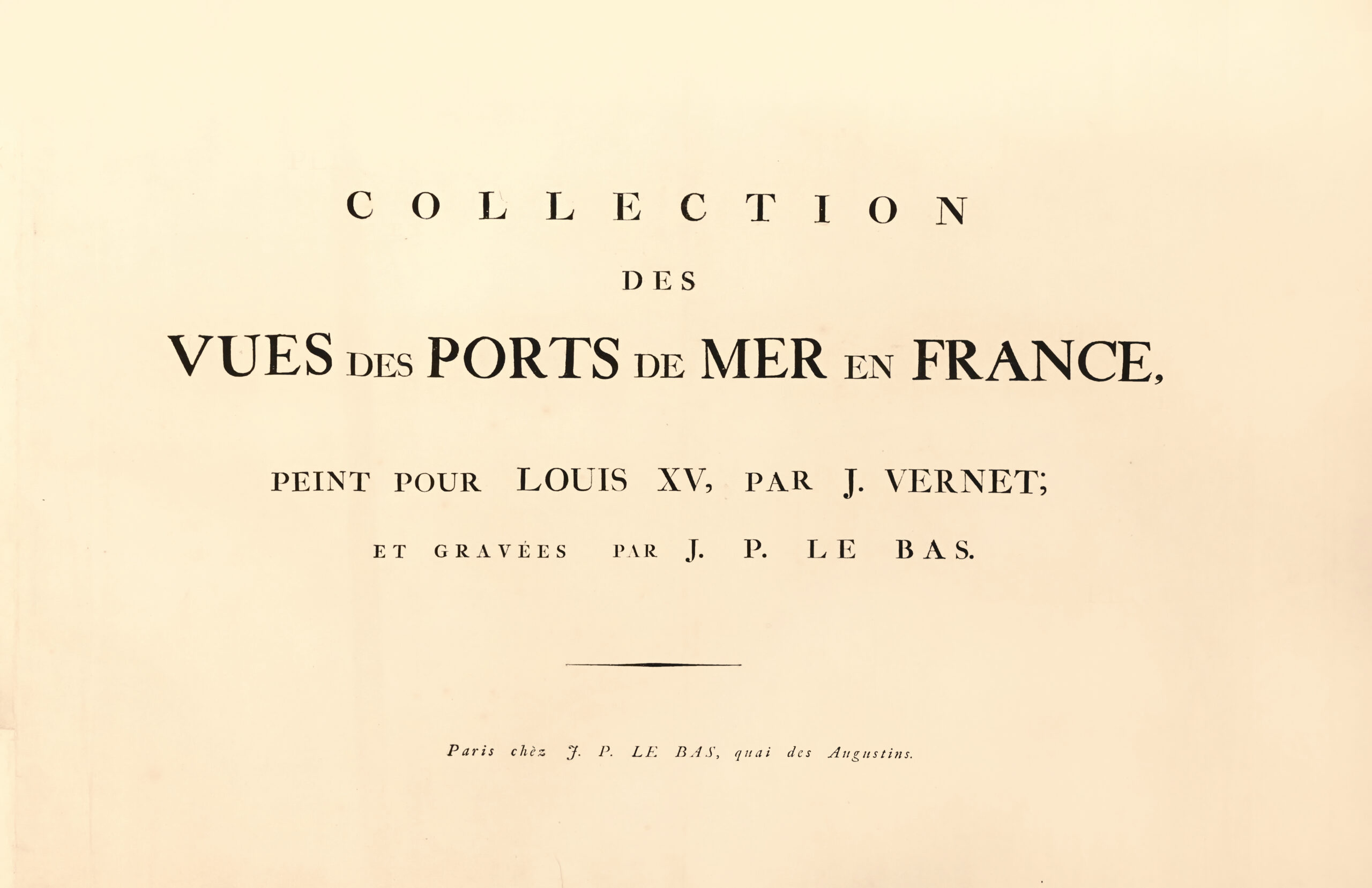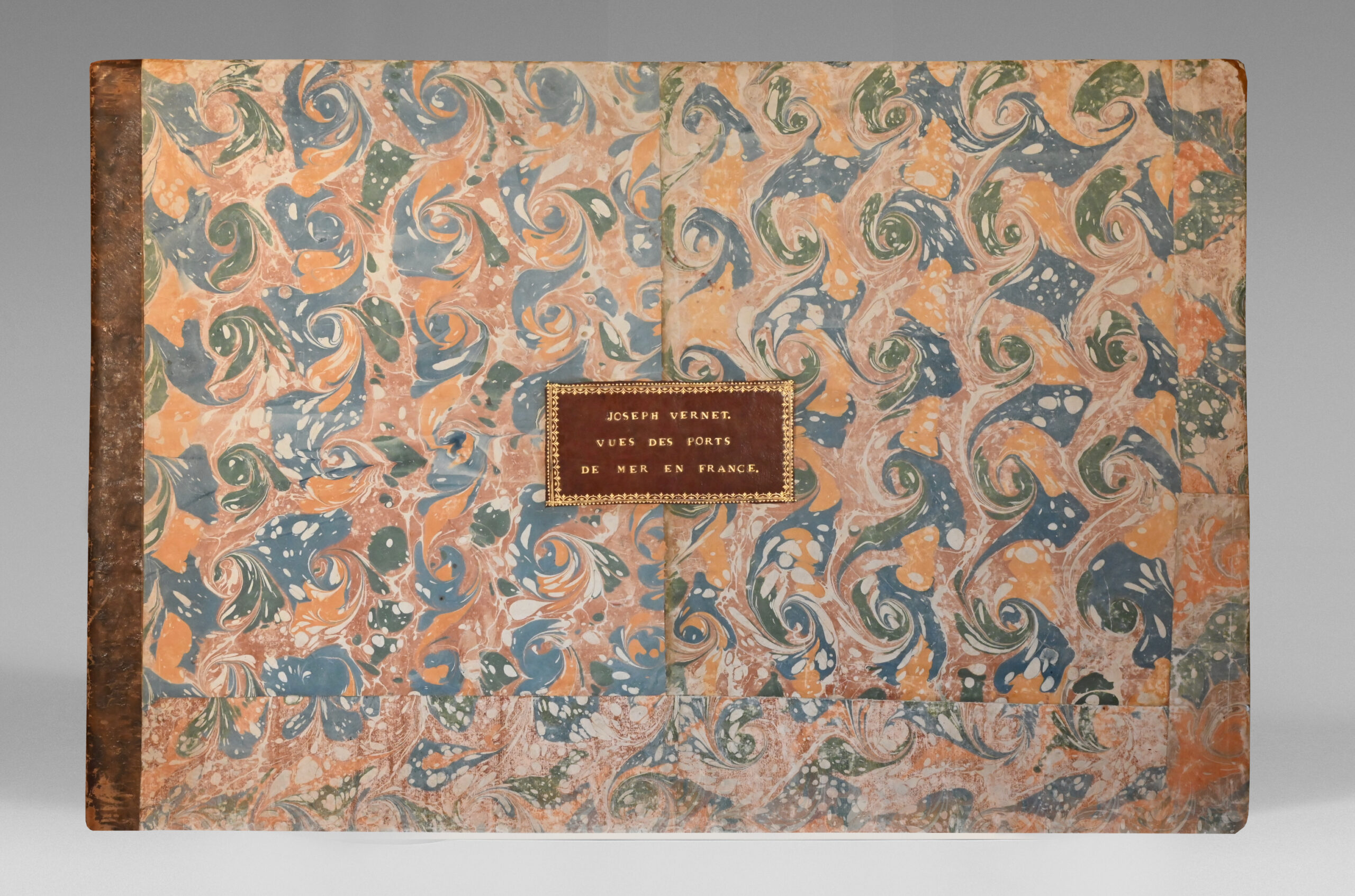Paris, J. P. Le Bas, [1760-1778].
Oblong in plano of (2) ll. 16 plates, contemporary binding with a spine in marbled light-brown calf decorated with gilt designs, red morocco cartouche surrounded with gilt lace and gilt title in the center of the covers, untrimmed. Contemporary binding.
800 x 550 mm.
Superb set of 16 views of ports after Joseph Vernet finely engraved by Charles-Nicolas Cochin and Jacques-Philippe Le Bas.
The copy includes the two additional plates – the last one (Le Havre) after Cochin – finished in etching by P. Martini.
Joseph Vernet did not produce any painting representing the port and the city of Le Havre. The plate n°16, attached to the series of engravings reproducing Joseph Vernet’s paintings, was drawn by C. N. Cochin and engraved by J. Ph. Le Bas.
Vernet was commissioned by the Marquis de Marigny, director general of the king’s buildings and brother of the Marquise de Pompadour, to depict the principal ports of France, a task he undertook in 1753.
After having painted Marseille and the Gulf of Bandol, he left for Toulon, then Antibes and Sète. From Bordeaux, where he was very well received, he went down to Bayonne and then up to La Rochelle and Rochefort. He settled in Paris in 1763 and went to Dieppe, the last port he represented. Nicolas Ozanne accompanied Joseph Vernet during part of his journey.
The royal commission was for twenty ports, but Vernet painted only nine, plus the bay of Bandol, from 1753 to 1765, resulting in fifteen pictures. The Seven Years’ War and the resulting financial difficulties suspended his work.
List of the sixteen plates:
Plate N°1. The new port or the Arsenal of Toulon, seen from the corner of the artillery park
– painting of 1755 – engraving of 1760.
Plate N°2. The interior of the port of Marseille, seen from the Pavilion of the Clock of the Park – painting of 1754 – engraving of 1760.
Plate N°3. The Madrague or the Fishing of the Tuna, seen from the gulf of Bandol – painting of 1754 – engraving of 1760.
Plate N°4. The entrance of the Port of Marseille, view of the Mountain called Tête de More – Painting of 1754 – engraving of 1760.
Plate N°5. The old Port of Toulon, seen from the side of the Magasins aux Vivres – painting of 1756 – engraving of 1762.
Plate N°6. The City and the Harbor of Toulon seen at mid-slope of the mountain which is behind – painting 1755 – engraving 1762.
Plate N°7. The Port of Antibes in Provence, seen from the Land side – painting 1756 – engraving 1762.
Plate N°8. The Port of Cette in Languedoc, seen from the sea side, behind the isolated jetty – painting 1756-57 – engraving 1762.
Plate n°9. View of the city and of the port of Bordeaux, seen from the side of the Salinières – painting 1757-59 – engraving 1764.
Plate N°10. View of the City and Port of Bordeaux, taken from the Château Trompette -painting 1757-59 – engraving 1764.
Plate N°11. View of the City and Port of Bayonne, taken from the Glacis of the Citadel – painting 1759-61 – engraving 1764.
Plate N°12. View of the City and Port of Bayonne, taken from the Alley of Bouflers, near the Gate of Mousserole – painting of 1759-61 – engraving of 1764.
Plate N°13. The Port of Rochefort seen from the Magasin des Colonies – painting of 1761-62 – engraving of 1767.
Plate N°14. The Port of La Rochelle, seen from the small Shore – painting of 1761-62 – engraving of 1767.
Plate N°15. View of the Port of Dieppe – painting 1763-65 – engraving of 1778.
Plate N°16. The Port and the City of Le Havre, seen from the foot of the Tower of François premier, 1776.
The king’s orders were clear: “your paintings must combine two merits, that of picturesque beauty and that of resemblance, as much as his intention: to see the ports of the kingdom represented in their natural state in your paintings”.
In Toulon, the food quay is a real exhibition of what could be found on board in terms of bags, jars, baskets, bottles and casks. Wine, salted meat, cheeses, dried vegetables, spices, and livestock were loaded onto the lighter on the quay, which was to be used to load ammunition aboard a departing ship.
In Marseille, on the quay of the old arsenal, at the end of the harbor, a lively and colorful crowd of women and men of the people mingled with gentlemen, women of quality and religious. Levantiers, Turks or turbaned Barbarians also walk the quays. The entrance of the port is animated by multiple boats, canoes, lighters, fishing boats, tartanes.
In Bordeaux, on the quai des Salinières, we see Jesuits, elegant young women in basket dresses, but also bakers and a cowboy; a precious tilbury launched at high-speed contrasting with a team of oxen dragging a heavy cart of barrels. On the river, commercial boats come to load the wine contained in the barrels aligned on the quay.
In Rochefort, here we are on the food quay: the barrels of Bordeaux wine, the cauldrons, the pots are intended to supply the ships, as well as the cattle which graze in the meadow. The bundles of sailcloth and the large skeins of hemp went to supply the workshops of the arsenal, including the magnificent rope factory that stretched out on the right.
In La Rochelle, amidst the bales, baskets, barrels, wood and anchors, men and women work, rest or discuss, in a word, live before our eyes, an attitude, a gesture, a look that makes them closer to us than long speeches on 18th century society.
While Vernet often takes great liberties with the king’s very precise requests for the choice of sites or the point of view from which he depicts them, he fully meets his wishes by describing everywhere scenes of daily life: before our eyes lives a whole people in the natural.
A picturesque testimony of the port life in France at the time of the navy and of the sweetness of life under the reign of louis xv the beloved.
A very rare collection of all the engravings of the views and ports of France, by Joseph Vernet, in their superb original state.
With Joseph Vernet and his direct descendants, the continuity of this school of Avignon, which, since the 14th century, has never ceased to manifest itself through artists of very different talents and characters, but united by indisputable affinities, is affirmed one last time. The origin of this school can be traced back to the time when Bertrand de Goth, archbishop of Bordeaux, who became pope under the name of Clement V, moved the pontifical court to Avignon. In this “small and peaceful city, whose charm could not escape them, the popes created a powerful artistic center, whose brilliance was to last until the 19th century. In Avignon, which still retains so many vestiges of its exceptional destiny, the young Joseph Vernet could encounter at every step monuments likely to give him a foretaste of the unique city that would later reveal him to himself. Opposite the Palace of the Popes stands the Mint, built by a Cardinal Borghese, the Pope’s legate, and which bears on its façade the dragon and the eagle, the family’s coat of arms. Finally, the Hill of the Gifts, where the view is so beautiful over the Rhone and Villeneuve, is a reduction of the Pincio gardens, which, together with the Villa Medici, make up one of the most beautiful places in Rome and the world.
Joseph Vernet felt the call of Italy at an early age, and his father, Antoine Vernet, was fortunate enough to interest in the brilliant gifts of the young painter several noble people of the city, in particular the Marquis of Caumont and the Count of Quinson, who opened their purse to him and allowed him to leave for Rome, which at that time offered incomparable resources to artists. But during his journey to the Eternal City, the first stage of which took him to Marseilles, Joseph Vernet had a momentous encounter with the sea, which appeared to him for the first time in all its beauty from the heights above the city. It was love at first sight, and when a few days later, after a spectacular storm, Vernet arrived in Civita-Vecchia, his destiny was fixed: he was to become a painter of the sea, which was to be present in almost all of his works. The young artist’s life in Rome was very pleasant; he was very well received and quickly gained a clientele eager for storms and storms. The books of reason of Vernet give us precise information on his works: in 1743 he was received member of the Academy of Saint Luke, a rather rare honor for a foreigner, the sea attracts him more and more, it is with joy that he goes on a pilgrimage to Naples, where the master whom he admires so much, Salvator Rosa, found the main source of his inspiration. However, in Rome, Vernet’s popularity grew day by day; his clientele became European. In Italy, Joseph had found fortune, fame and love; he was in no hurry to leave a country that had received him so well. However, solicited by his French patrons, he decided to return permanently to his country, but he returned to Italy several times and it was not until 1753 that he settled in France for good. Thanks to the high patronage of M. de Marigny, supreme director of Fine Arts and brother of Madame de Pompadour, who had at that time all the favor of Louis XV, Vernet obtained from the king a commission where he was to give the full measure of his talent: The Ports of France. The sea, which had inspired him so often in his earlier works, was to provide him with another important theme, but this time it would only complement his compositions; for a time he would stop painting storms, tempests and gales. These ports of France will be landscapes where truth and fantasy mingle pleasantly, witness this Port of Marseilles, luminous and gilded like a Claude Gellée, which shows us in the foreground a group gathered for an open-air tea party, another for a ball; the dresses and parasols of the women enliven this landscape with such noble lines and give it an air of family celebration.
The same process is used in the Vue de la Ville et de la Rade de Toulon (View of the City and the Harbor of Toulon), where we see, halfway up the hills overlooking the harbor, horsemen, hunters, bowlers and ladies in their best clothes, busy on a monumental terrace. This desire to humanize the landscape can be found in almost all of Vernet’s works, even in those where it might seem artificial; in storms, shipwrecks, tempests, we will always see man opposing the blind force of the elements with his courage, his ingenuity or his despair. This introduction of the human drama in the middle of the picturesque aspects of a hostile nature, it is there the true originality of Joseph Vernet.
“It is a great magician, that this Vernet, writes Diderot, one would believe that he begins by creating a country and that he has men, women, children in reserve, of which he populates his canvas as one populates a colony, then he makes them the sky, the time, the season, the happiness, the misfortune that it pleases to him. The production of J. Vernet is considerable and his contemporaries loved him. In this work devoted almost exclusively to the sea, to storms, and to tempests, one can distinguish at least two periods, a Roman period deeply marked by the Neapolitan painters, Salvator Rosa and Solimena, whom he admired without reserve; he owes them this dramatic feeling of nature and this breadth of facture that he manifested from his first works.
On his return to France, his art became more human and was enriched with tasty details which, far from altering its character, gave it a great deal of charm. Certainly, J. Vernet heard the message of Poussin and Claude Gellée, but to the sublime of the one and the mystery of the other, he substituted a human and familiar pathos, and if he does not reach their greatness, he keeps a closer contact with his century and a wider audience by speaking a more accessible language. After Watteau’s fêtes galantes and Boucher’s Bergeries, nature as Vernet conceives it, however well prepared it may seem to us, is a true nature and not an opera set. If Vernet had an obvious influence on the taste of his time, it is more difficult to perceive his passage into modern painting. Yet many works that still delight us bear his indisputable mark; how can we not think of him in front of Hubert Robert’s Ruins and Waterfalls and, closer to us, how can we forget the Ponte Rotlo when admiring the Corots of Italy? Fortunately, posterity, so severe towards the recent glories, apparently the most solid, and which it so readily precipitates into hell or purgatory, revises sooner or later its most definitive judgments; and while the great battles of Horace Vernet are no longer in demand, the glory of the great painter of the Ports of France, so amiable and so French, still appears to us as pure and as justified.” J. Dupuy.
A very fine copy with wide margins bound in light-brown half-calf.
